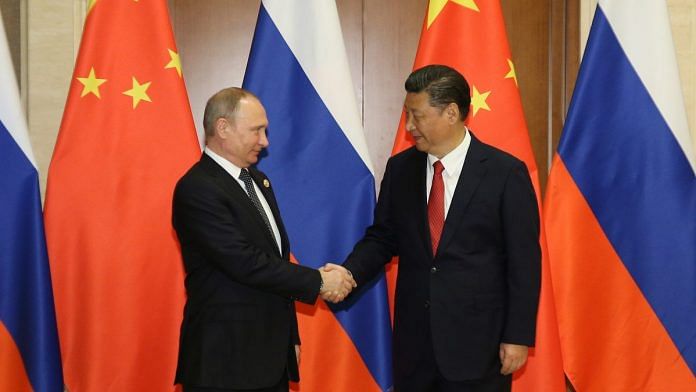Global warming equals polar trading
“The unprecedented melt of Arctic sea ice is sounding alarm bells around the globe, but it’s also rejuvenating hopes of a shipping shortcut across the top of the world. It shouldn’t be,” write Keith Johnson and Reid Standish in Foreign Policy.
China, they write, is “dreamy-eyed” about shipping goods to Europe via Russia, and have visions of an Arctic strategy that could change the transpolar shipping world. “Some specialized tankers are making headlines by crossing the Arctic alone — in the dead of winter, something that was almost impossible before.”
At the same time, the melting Arctic bears good news for Russia as it can “open up a new economic frontier rich in oil, natural gas, and lucrative transport routes between the world’s workshop and the world’s consumers.”
“The Northern Sea Route, which stretches roughly from Murmansk in the west to the Bering Strait in the east, has become the focal point of both Russia and China’s Arctic strategy. That’s because it promises a route that’s one-third quicker from Asia to Europe than going the long way around via the Suez Canal, and offers a way to rejuvenate a depressed part of Russia.”
“Today, thanks to billions in Russian investment and runaway Arctic warming, it’s opening up again — but that doesn’t mean it is going to be a rival to traditional shipping routes anytime soon. While ice-free seas mean there’s a longer shipping season than there used to be, and the route is thousands of miles shorter than the long way around, the economics of shipping through the Arctic don’t make much sense today and likely won’t for decades to come,” write Johnson and Standish.
“Beijing’s vision for the Arctic — dubbed the “Polar Silk Road” — has now been lumped into its sprawling, trillion-dollar Belt and Road initiative, the signature foreign-policy project of President Xi Jinping,” they write.
Donald Trump vs. “The Koreas”
“South Korean conservatives have had two nightmare scenarios about President Trump: that he would either embroil their country in a ruinous war with North Korea or that he would sell out their interests to the North,” writes Max Boot in the Washington Post.
Trump has been doing his best to upset North Korea. He has threatened “fire and fury”, and has called Kim Jong-un “Little Rocket Man”. “Now, in a head-snapping display of incoherence, Trump has agreed to meet Kim, giving the worst human-rights abuser on the planet, what he most wants: international legitimacy. Kim will be able to tell his people that the American president is kowtowing to him because he is scared of North Korea’s mighty nuclear arsenal.”
Moon Jae-in, the South Korean president, played his cards just right during the Winter Olympics in a stunning display of sports diplomacy, managing to keep both the US and North Korea happy, while at the same time one-upping the US. “Moon and Kim have, for their own reasons, snookered the credulous American president into a high-profile summit that is likely to end in disaster one way or another. Kim is evidently willing to suspend his nuclear and missile tests while the talks are under way, but this is a minimal concession that can easily be reversed.”
“The South Koreans claim that the North Koreans are willing to discuss denuclearization, but the likelihood is that they will only do so on terms that the United States should never accept,” predicts Boot.
“It may make sense to talk to North Korea, but at a lower level, while maintaining the “maximum pressure” sanctions policy. Eventually the regime may feel so much pain that it will be willing to bargain in earnest. But there is no reason to think that the time is now and much reason to assume that Trump, as usual, doesn’t know what he is doing,” he writes.
All eyes to Rome
“Italy’s election this week has destroyed any remaining hope that the center in European politics can prevail,” writes Helen Thompson in the New York Times. “On the same day that members of the Social Democratic Party in Germany gave reluctant blessing to another “grand coalition” in Berlin, Italians went to the polls and delivered more than half their votes to anti-establishment parties. The center-right coalition that emerged when Silvio Berlusconi formed Forza Italia is now led by the League, a far-right party that threatens thousands of migrants with deportation. And as in nearly every recent European election, the principal center-left party lost a large number of voters. Given these results, the only possible government that can emerge in Rome will contain at least one of the two insurgent populist parties: either the League or the Five Star Movement, the single largest party in Parliament.”
Italy is not a unique case. Across the European continent, Thompson writes, politics has shattered. “The once-dominant parties of the center right and center left have been unable over the past two decades to secure support for policies generated within the context of the European Union and the euro single currency.”
“Much of Europe has become nearly ungovernable. As voters across the Continent see their ability to influence policy taken away, they have lashed out, neutering the traditional center and giving rise to disruptive populists. Italy’s election, in other words, says much about everything that’s wrong with the European Union.”
“Italy is the epicenter of the problems facing establishment European politicians for both recent and more historical reasons,” Thompson writes.
“So when the next government in Rome, deliberately or not, pushes Italy ever closer to a decision about leaving the eurozone, in all likelihood it will take the European Union to its own precipice.”



